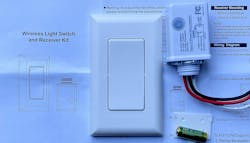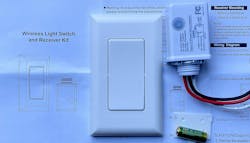While Sec. 404.1 makes it clear that wireless or battery-powered switches like the one shown in the Photo are not covered by Art. 404, the informational note following Sec. 404.1 provides an important reminder for other requirements found in Sec. 210.70, which may apply to battery-powered switches.
During the 2020-2023 Code revision cycle, one Public Input and four Public Comments were submitted to Sec. 210.70 addressing battery-powered switches. CMP 2 comments indicated they were concerned that a dead battery would prevent the lights from turning on, which could potentially impede safe egress. They ultimately decided to revise Sec. 210.70 through First Revision No. 9148 (FR-9148-NFPA 70-2021) for the 2023 edition. The revised wording stated, “Lighting outlets shall be installed where specified in Sec. 210.70(A), (B), and (C). The switch or wall-mounted control device shall not rely exclusively on a battery unless a means is provided for automatically energizing the lighting outlets upon battery failure”.
When I read the final wording, I was wondering how manufacturers would be able to produce such a switch. Well, as it turns out, it’s virtually impossible to produce a switch capable of sending a signal to turn lights on if the battery in the switch is dead. In fact, that type of functionality could be dangerous too. Imagine if you pressed the switch to turn the lights off so you could make some repairs to the light only to have the switch automatically energize the light unexpectedly while you were working on it. Boy, that could be really dangerous if you suddenly received a shock while working high up on ladder.
While safe egress is certainly a concern, many other failures could also prevent a light from working too. Lamps burn out, breakers trip, fuses blow, splices can fail, and utility power outages can all leave an area in the dark too. Due to these reasons and manufacturing limitations, Tentative Interim Amendment (TIA) 23-15 was issued on Nov. 30, 2023, with the following revised wording for the second sentence of Sec. 210.70: “The switch or listed wall-mounted control device shall not rely exclusively on battery power unless it incorporates a positive means of notification of impending battery depletion.”
This revised functionality should provide a safer installation without placing undue burdens on switch manufacturers. Smoke alarms and carbon monoxide alarms typically chirp or flash an LED when their batteries are low, so I would imagine switch manufacturers would be able to incorporate a similar function into battery-powered switches. Please keep in mind, however, that TIA 23-15 would be applicable only if your jurisdiction has adopted the 2023 Code edition along with TIA 23-15.
About the Author

Russ LeBlanc
Owner
Russ started in the electrical trade as an apprentice in 1985. He worked his way up to become a Journeyman Electrician and then eventually became a Master Electrician and Licensed Construction Supervisor. In 1999 Russ become an Electrical Instructor for The Peterson School of Engineering in Massachusetts where he developed his passion for teaching, and quickly became Department Head of Electrical Instruction. Russ has taught thousands of apprentices, electricians, engineers, inspectors, and other electrical professionals during his career as an instructor. He continues to provide electrical professionals with Electrical Code seminars, Arc-Flash Awareness training seminars and educational material through his LeBlanc Consulting Services in North Reading, MA whose specialty is educating electricians. He has been an active member of the NFPA Electrical Section and has authored hundreds of National Electrical Code proposals and comments which have become Code rules to improve the safety for the electrical industry. Russ is also an IAEI certified Electrical Inspector.
Please visit www.russleblanc.net for more information.

